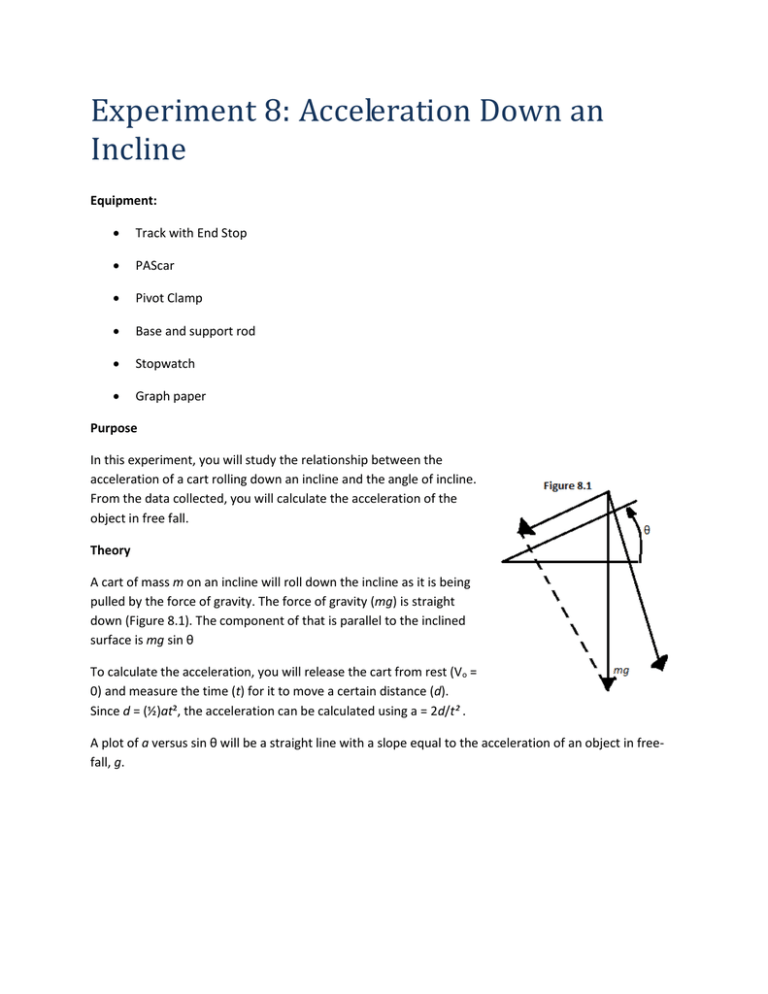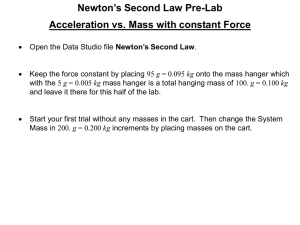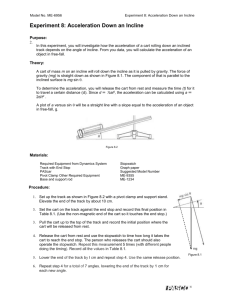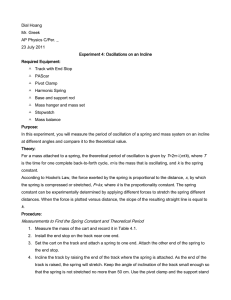Experiment 8: Acceleration Down an Incline
advertisement

Experiment 8: Acceleration Down an Incline Equipment: Track with End Stop PAScar Pivot Clamp Base and support rod Stopwatch Graph paper Purpose In this experiment, you will study the relationship between the acceleration of a cart rolling down an incline and the angle of incline. From the data collected, you will calculate the acceleration of the object in free fall. Theory A cart of mass m on an incline will roll down the incline as it is being pulled by the force of gravity. The force of gravity (mg) is straight down (Figure 8.1). The component of that is parallel to the inclined surface is mg sin θ To calculate the acceleration, you will release the cart from rest (Vo = 0) and measure the time (t) for it to move a certain distance (d). Since d = (½)at², the acceleration can be calculated using a = 2d/t² . A plot of a versus sin θ will be a straight line with a slope equal to the acceleration of an object in freefall, g. Procedure 1. Using a pivot clamp and a support stand set the track up as shown in figure 8.2. Raise the end of the track about 10 cm. 2. Put the cart on the track against the end stop and record this final position in table 8.2. (use the non-magnetic end of the cart so it touches the end stop.) 3. Pull the cart up to the top of the track and record the initial position where the cart will be released from rest. 4. Release the cart from rest and use the stopwatch to time how long it takes the cart to reach the end stop. The person who releases the cart should also operate the stopwatch. Repeat this measurement 10 times (with different people doing the timing) Record all the values in table 8.1. 5. Lower the end of the track by 1 cm and repeat step 4 using the same release position. 6. Repeat steps 4 and 5 for a total of 7 angles. Table 8.1: Data Initial release position = Final position = Distance traveled (d) = 10 cm T Trial 1 Trial 2 Trial 3 Trial 4 9 cm 8 cm Height of Track 7 cm 6 cm 5 cm 4 cm I M E Trial 5 Trial 6 Trial 7 Trial 8 Trial 9 Trial 10 Data Analysis 1. Calculate the average time for each angle and record it in table 8.1. 2. Calculate the distance traveled, d, from the initial to the final position. 3. Use the distance traveled and average time to calculate the acceleration for each angle and Table 8.2 Height 10 cm 9 cm 8 cm 6 cm 5 cm 4 cm Acceleration Sin θ record it in table 8.2. 4. Measure the hypotenuse of the triangle formed by the track and use this to calculate sin θ for each angle. Hypotenuse = ______ 5. Plot acceleration versus sin θ. Draw the best-fit straight line and calculate its slope. Calculate the percent difference between the slope and g = 9.8m/s² Slope = __________________ Percent difference = _______ Questions 1. Does your reaction time in operating the stopwatch cause a greater percentage error at higher or lower track angles? 2. How will doubling the mass of the cart affect the results? Try it.




